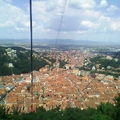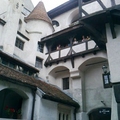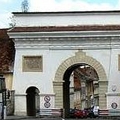Destinations / The Best Places to Visit in Brasov, Romania / St. Bartholomew Church
St. Bartholomew Church
St. Bartholomew's Church is the oldest building in the city. It was built in the thirteenth century and was known as the Church of the three orphans, which according to the legend had left all they had to the church that’s why they were buried under the altar. The building with three naves with massive buttress walls, surrounded by walls outlasted the Turkish
invasion and the great fire of 1689 and the devastation troops of Vlad Tepes (1458) and of Gabriel Bathory (1611). The church tower was rebuilt and highered with a floor in 1842 after the collapse due to the earthquake in 1822. The altar dates from 1791 and an old pew in 1683. The northern, the western and the south-western medieval defense walls are original, and the eastern and the northern parts were demolished and rebuilt. The surrounding walls are of parishioners Saxon cemetery of Bartholomew.
For more than 500 years, the last Sunday before the day of 24 of august (St. Bartholomew's Day) is the pilgrimage to the feast of St. Bartholomew. He conducted a regional festival where communities met Saxon Barsa following the celebration ceremony of German folk songs and dances accompanied by fanfare .In 2003 in the church opened an ethnographic museum with over 1,500 items donated by emigrants, showing typical household of Saxon tissues, furniture port Saxon in carpentry, bakery.
Others from The Best Places to Visit in Brasov, Romania
Due to numerous historical and artistic monuments Brasov is one of the most important tourist centers of the country.
The city is divided into two distinct components: the area with baroque influence that winds from the foot of the mountain and the massive Postavaru and the large area with buildings and factories.
The main attraction is the old town - Schei, yet glamorous, where you will find plenty of houses and antiques, especially religious.
Brasov is located in the central-eastern part of Romania, at the foot of Tampa (967m).
The administrative territory of Brasov is within the southern part of the basin Brasov, in the internal flow of the Eastern Carpathians.
The region consists of two distinct units: Brasov and the Carpathians and at the contact between them developed a series of activities following the foothills of external factors, namely , Sacele and Rasnov.
Brasov climate is temperate continental specifically characterized by a note-type transition between temperate oceanic and the continental temperate: wetter and cooler mountain areas with relatively low rainfall and temperatures slightly lower in low areas .
Temperature inversions are numerous, therefore, minimum winter temperatures do not fall in the extremes, the annual average of 7.
6 degrees Celsius.
The rainfall is relatively high due to the small diurnal contrasts.
Historical data: Brasov is documented in 1234 in the Catalogue Ninivensis named Corona.
In the second half of the XIV century, is confirmed as the administrative and ecclesiastical center of Barsa, (Corona, Kronstadt, Brasso), "free royal city" one of the economic and cultural centers of Transylvania.
In the Renaissance, "Brasov these times stands out, compared to other cities, the cultivation of the sciences" noted in 1548, the great humanist and reformer Johannes Honterus sas (1498-1549), in a letter to Sebastian Munster, professor of University of Basel.
The prestige of the school and library founded by Honterus in 1541 - Studium Coronense - was to attract students from all over Transylvania, Hungary, Germany and the Netherlands.
Johannes Honterus introduced religious reform Barsa Saxons, and in 1547 the Principality Diet accepted Lutheran religion as one of the four official religions allowed in Transylvania.
Between 1639 and 1641, Brasov fortifications are amplified in the north of the city with several rows of curtains and moats.
Bastion in 1646 ended the defensive system works.
In 1689, the most devastating fire in the history of Brasov affects most important buildings of the Citadel.
Weight restoration unfolds city and rebuild the destroyed buildings is consistent with new styles: Baroque, Rococo, Classical.
The transformation from a medieval town into a modern city imposed extension to the north-east (toward Old and Blumana) and west (toward Schei), by demolishing the fortified seat of the city that began in 1857 (Gate Street and fortifications therein), Street Wear Black (1873), Fair Gate Horses (1874), Bastion (1886), Bastion harness (1887).
The old moats, ponds and swamps were filled, rose administrative and public buildings, schools, barracks and houses were decorated with parks and promenades.
Nowadays Brasov is one of the most beautiful cities of Romania to be visited with many , many places of visit that attract tourist all over the world all the year round.






